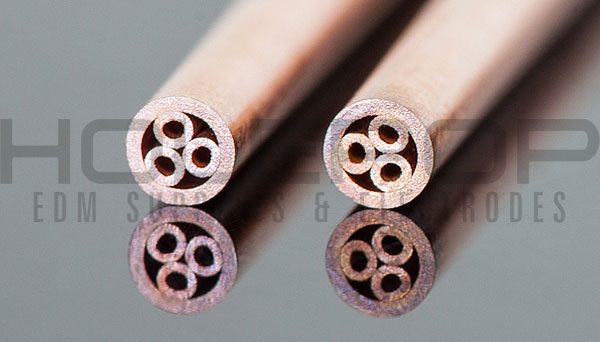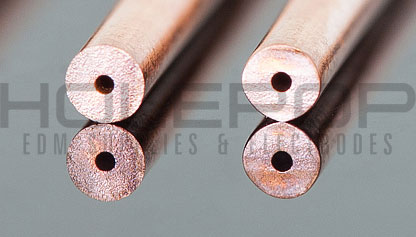

Copper EDM Electrodes
Copper Electrode Characteristics
- Electrode Spec Sheet
- Our copper electrodes come in both single hole and multi channel (coreless) varieties, including web type, two hole, three hole, and y type electrodes.
- Our copper electrodes can be used with a wide variety of materials, such as: carbon steel, nitronic 60, carbide, tungsten carbide, molybdenum, beryllium, sintered diamond, silicon ingot, titanium, hastelloy, kovar, invar, and inconel.
- We have been using the same alloy specification for over 15 years with a 99.9% purity standard.
- We offer copper electrodes in a variety of lengths from 4 inches (100mm) to 27.5 inches (700mm).
- Custom lengths are available upon request.
Oxygen Free Copper
Though 99.9% purity may be enough for most applications, sometimes electrodes approaching absolute purity are required. Oxygen free copper is up to 99.97% pure, allowing for a material whose properties most closely resemble those of elemental copper. For an electrical discharge machinist, this means high conductivity. High conductivity increases efficiency, lowering thermal expansion of electrodes and decreasing the wear on electrodes.
When Should I Use Copper Electrodes?
- When a lower wear rate is required. The fast disintegration rate of brass confers no increase in drilling speed when the target material is resilient. The lower disintegration rate of copper leads to greater efficiency in comparison to brass when the target material is tough.
- When the workpiece is made of tough materials including metals such as carbide, tungsten, or a mixture of tungsten carbide, and exotic materials such as carbon carbon, sintered diamond, or silicon/silicon carbide copper is the preferred electrode material.
When Should I Not Use Copper Electrodes?
- When the target material is relatively soft. The slower disintegration rate of copper confers no increase in efficiency when the target material is relatively soft. The faster disintegration rate of brass leads to faster drilling when the hardness of the target material is a non issue.
- Softer materials include mild, tool, stainless, and alloy steel.
Should I Use a Single Hole Brass Electrode or a Multi Channel Brass Electrode?
Single Hole Electrode Tubes vs. Multi Channel Electrode Tubes
The hollow portion of an electrode exists to facilitate the flow of dielectric fluid through the electrode. This serves to cool down the electrode, which is very important, as an overheated electrode can result in warping and a corresponding drop in precision. It also flushes loose material from the hole that is being drilled. Both types of tubing accomplish this; however, whether a copper electrode has a single hole or a multi channeled hole running through its ID (internal diameter) often determines the ultimate success of EDM drilling through a material or work piece.
-
Multi Channel
This is a consequence of the unique challenges presented by blind hole EDM drilling. Blind hole EDM drilling as opposed to through hole drilling penetrates a material but does not exit through the material. A single hole EDM electrode does not spark where the hole is, and consequently leaves a nipple in the drilled hole. Multi channel electrodes are built such that no one part of the target material is left unaffected by the sparking electrode as it spins.
-
Single Hole
Through hole drilling, on the other hand, does not require material left over by a single hole electrode to be burned away. Such material simply falls away from the workpiece. As a result, single hole electrodes are ideal for this application. Due to the smaller amount of material used in a single hole electrode and their simpler construction, they are also cheaper than multi channel electrodes.
Copper EDM Tubes and Your Specific EDM Drilling Machine
Today’s EDM Drilling Machines are far more advanced than ever before. With the various preset power settings available, our copper EDM tubes will work effortlessly with any machine. Some EDM drilling machines prefer copper as opposed to brass. This is unique to your exact machine as there are many different EDM drill machines on the market.
Holepop Product Information
- All tubing is backed with a rock solid 100% product guarantee.
- If you are not satisfied with our EDM consumables and EDM tubes we will either replace them or refund you the total cost.
- We offer fast, reliable, and completely customizable shipping to suit your needs.
- Holepop uses UPS, DHL, FedEx, and any other international courier to ship anywhere in the world.
- All brass and copper EDM electrodes are supplied in packs of 100 pieces.
- Place an order here or call (714) 222-9899 to speak directly to our EDM Hole drilling specialists.



Leave a Reply